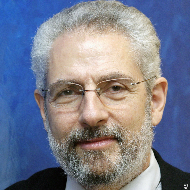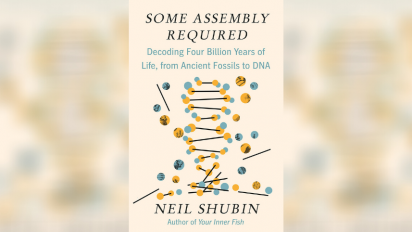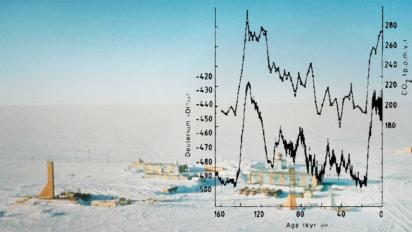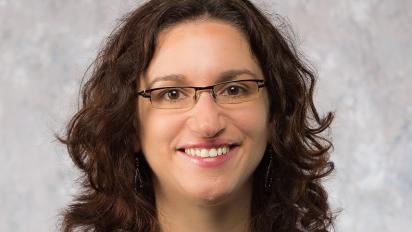Vostok Station: Climate change is real
In this Place & Time article, Spencer Weart recounts how scientists laboring under challenging conditions in one of the coldest places on earth corroborated computer models predicting how warm the earth would get due to anthropogenic climate change.
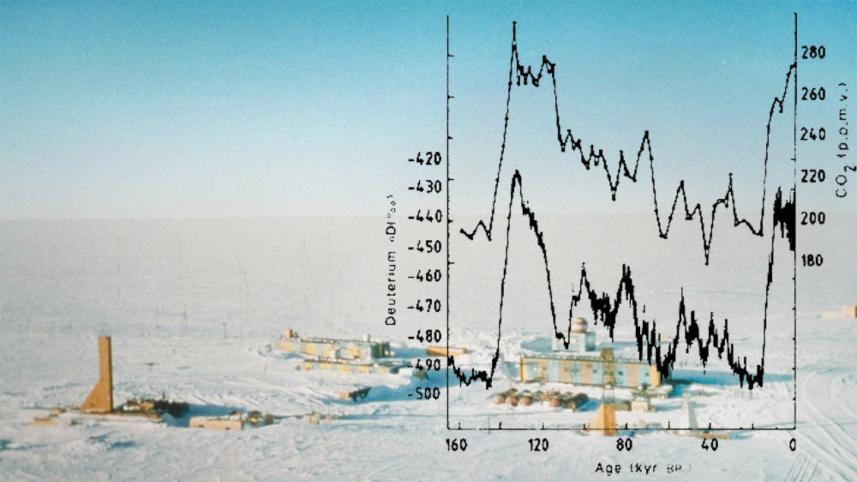
The Vostok Station. Upper curve: CO2; lower: temperature from 160,000 years ago to recent (today the level is much higher). Figure adapted from figure 1 of J. M. Barnola, D. Raynaud, Y. S. Korotkevich, and C. Lorius, “Vostok ice core provides 160,000-year re-cord of atmospheric CO2,” Nature 329 (1987): 408–414.
How warm would Earth get? By the mid-1980s computer models had converged on a rough answer: when the amount of carbon dioxide (CO2) in the atmosphere doubled, as expected sometime in the 21st century if we kept burning fossil fuels, the average rise would be three degrees Celsius plus or minus 50 percent. (Today’s models confirm this, giving a lower limit of 2 degrees and an upper limit of 5.) That would be dangerous even at the lower limit and catastrophic at the upper. But how reliable were the computer models? The scientific community pegged the studies as “bleeding edge” research, uncorroborated, nowhere near what could persuade people to make radical changes in the global economy. It was theoretical, abstract. Was there any real evidence that changes in CO2 could change a planet’s temperature?
The answer came from the coldest place on Earth — and the sunniest.
In 1957 the Soviet Union had established the Vostok research station near Antarctica’s “Pole of Inaccessibility.” Vostok holds the record for the lowest temperature ever reported (-89.2 °C), and it is always well below zero there. Yet on a windless summer day you can almost feel warm as the sun circles the horizon unceasingly across the blinding-white snow. The air is thin, for the Vostok station stands on top of more than three kilometers of ice. In 1970 they began to drill a hole.
This was a heroic feat of technology, wrestling with drill heads stuck a kilometer down at temperatures so low that a puff of breath falls to the ground in glittering crystals. Supplies were brought once a year by a tractor convoy that clawed for weeks across 1400 kilometers of ice. Underfunded and threadbare, the station was fueled by the typically Russian combination of cabbage, cigarettes, vodka, and stubborn persistence. (In 2000, a journalist for Science News asked, “What do you do for recreation?” and was told, “Wash ... you have a bath once every ten days.”) In April 1982 the generator shed caught fire; the chief mechanic, Aleksei Karpenko, died in a futile attempt to save it. The main generators were wrecked and no resupply was possible until November. The crew survived the winter by crowding into a little hut warmed by wicks dipped in diesel fuel.
Nothing would stop them. Layer by layer they drilled down into the past. By 1985 they had pulled up fat cylinders of ice as clear as glass stretching through the last Ice Age and into the preceding warm period, a complete glacial cycle of 160,000 years. Short on funds as the Soviet Union collapsed, they shared the ice cores with a team of French scientists for analysis. Trapped in the ice were microscopic bubbles of fossil air, unchanged for tens of millennia. You could measure the ancient CO2 level directly. And you could analyze isotopes of oxygen in the ice to find the temperature of the snow crystals when they fell long ago.
The results were plain as day. During the coldest parts of the glacial cycle, the CO2 level had been much lower than during the warm periods before and now. Indeed, the curves of gas level and temperature tracked one an-other remarkably closely. It was like putting Earth on a laboratory bench, switching conditions back and forth and observing the consequences. Yes, CO2 and global temperature change were tightly linked. Better still, you could get numbers. A doubling of the CO2 level accompanied a rise in temperature of 3 °C, give or take 50 percent — just what the computer models calculated.
Many in the scientific community saw the Vostok results as the first solid proof that global warning was truly a threat. Nothing in science is more convincing than getting the same number by two totally different methods. That is when you feel you have touched reality.
This version may differ slightly from the print publication.

